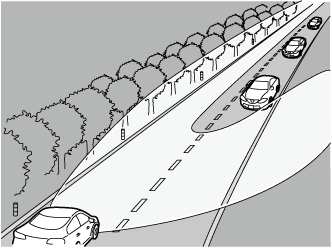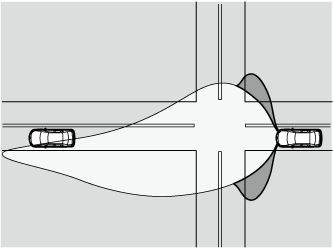

Adaptive LED Headlights (ALH) (Some Models)
The ALH are a system which uses the Forward Sensing Camera (FSC) to determine the situation of a vehicle ahead or a vehicle approaching in the opposite direction while driving at night to automatically switch the illumination range of the headlights, the illuminated area, or the illumination brightness.
Refer to Forward Sensing Camera (FSC) (Search).
The ALH are controlled between high and low beams as follows to assure the driver’s visibility without dazzling a vehicle ahead or a vehicle approaching in the opposite direction.
Glare-Free High Beam
This feature dims only the high-beam light shone on the vehicle ahead.
The high beams will dim while driving at a speed of about 40 km/h (25 mph) or faster. When the vehicle speed is less than about 30 km/h (19 mph), the beams switch to the low beams.

Wide-Range Low Beam
This feature extends the illumination range of the light cast by the low beams while driving at a speed less than about 40 km/h (25 mph).

Highway Mode
This feature shifts the illumination angle of the light cast by the headlights upward while driving on highways.

The distance in which the ALH can detect objects varies depending on the surrounding conditions.
-
Do not modify the suspensions or headlight units, or remove the camera. Otherwise, the ALH may not operate normally.
-
Do not rely excessively on the ALH and drive the vehicle while paying sufficient attention to safety. Switch the headlights between the high beams and low beams manually if necessary.
Under the following conditions, the ALH may not operate normally. Manually switch between the high and low beams according to the visibility, and the road and traffic conditions.
-
When there are other sources of light in the area such as street lamps, illuminated signboards, and traffic signals.
-
When there are reflective objects in the surrounding area such as reflective plates and signs.
-
When visibility is reduced under rain, snow and foggy conditions.
-
When driving on roads with sharp curves or undulations.
-
When the headlights/rear lamps of vehicles ahead or in the opposite lane are dim or not illuminated.
-
When there is insufficient darkness such as at dawn or dusk.
-
When the luggage compartment is loaded with heavy objects or the rear passenger seats are occupied.
-
When visibility is reduced due to a vehicle ahead spraying water from its tyres onto your windscreen.




